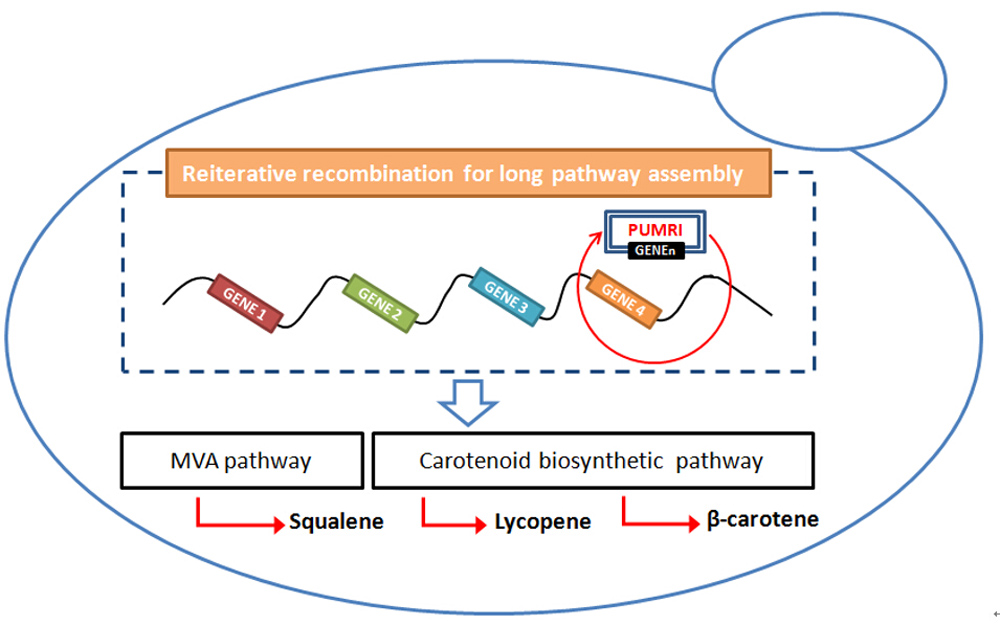

Frontiers of Chemical Science and Engineering >
Assembly of biosynthetic pathways in Saccharomyces cerevisiae using a marker recyclable integrative plasmid toolbox
Received date: 21 May 2016
Accepted date: 09 Aug 2016
Published date: 17 Mar 2017
Copyright
A robust and versatile tool for multigene pathway assembly is a key to the biosynthesis of high-value chemicals. Here we report the rapid construction of biosynthetic pathways in Saccharomyces cerevisiae using a marker recyclable integrative toolbox (pUMRI) developed in our research group, which has features of ready-to-use, convenient marker recycling, arbitrary element replacement, shuttle plasmid, auxotrophic marker independence, GAL regulation, and decentralized assembly. Functional isoprenoid biosynthesis pathways containing 4–11 genes with lengths ranging from ~10 to ~22 kb were assembled using this toolbox within 1–5 rounds of reiterative recombination. In combination with GAL-regulated metabolic engineering, high production of isoprenoids (e.g., 16.3 mg∙g‒1 dcw carotenoids) was achieved. These results demonstrate the wide range of application and the efficiency of the pUMRI toolbox in multigene pathway construction of S. cerevisiae.

Key words: pathway assembly; toolbox; reiterative recombination; S. cerevisiae; biosynthesis
Lidan Ye , Xiaomei Lv , Hongwei Yu . Assembly of biosynthetic pathways in Saccharomyces cerevisiae using a marker recyclable integrative plasmid toolbox[J]. Frontiers of Chemical Science and Engineering, 2017 , 11(1) : 126 -132 . DOI: 10.1007/s11705-016-1597-8
| 1 |
Ajikumar P K, Xiao W H, Tyo K E J, Wang Y, Simeon F, Leonard E, Mucha O, Phon T H, Pfeifer B, Stephanopoulos G. Isoprenoid pathway optimization for taxol precursor overproduction in Escherichia coli. Science, 2010, 330(6000): 70–74
|
| 2 |
Alper H, Miyaoku K, Stephanopoulos G. Construction of lycopene-overproducing E. coli strains by combining systematic and combinatorial gene knockout targets. Nature Biotechnology, 2005, 23(5): 612–616
|
| 3 |
Chang M C, Keasling J D. Production of isoprenoid pharmaceuticals by engineered microbes. Nature Chemical Biology, 2006, 2(2): 674–681
|
| 4 |
Dugar D, Stephanopoulos G. Relative potential of biosynthetic pathways for biofuels and bio-based products. Nature Biotechnology, 2011, 29(12): 1074–1078
|
| 5 |
Lange B M, Croteau R B. Improving peppermint essential oil yield and composition by metabolic engineering. Proceedings of the National Academy of Sciences of the United States of America, 2011, 108(41): 16944–16949
|
| 6 |
Tai M, Stephanopoulos G. Engineering the push and pull of lipid biosynthesis in oleaginous yeast Yarrowia lipolytica for biofuel production. Metabolic Engineering, 2013, 15(1): 1–9
|
| 7 |
Xie W, Liu M, Lv X, Lu W, Gu J, Yu H. Construction of a controllable b-carotene biosynthetic pathway by decentralized assembly strategy in Saccharomyces cerevisiae. Biotechnology and Bioengineering, 2014, 111(1): 125–133
|
| 8 |
Zhou P, Ye L, Xie W, Lv X, Yu H. Highly efficient biosynthesis of astaxanthin in Saccharomyces cerevisiae by integration and tuning of algal crtZ and bkt. Applied Microbiology and Biotechnology, 2015, 99(20): 8419–8428
|
| 9 |
Xie W, Lv X, Ye L, Zhou P, Yu H. Construction of lycopene-overproducing Saccharomyces cerevisiae by combining directed evolution and metabolic engineering. Metabolic Engineering, 2015, 30: 69–78
|
| 10 |
Lv X, Wang F, Zhou P, Ye L, Xie W, Xu H, Yu H. Dual regulation of cytoplasmic and mitochondrial acetyl-CoA utilization for improved isoprene production in Saccharomyces cerevisiae. Nature Communications, 2016, 7: 12851
|
| 11 |
Yamano S, Ishii T, Nakagawa M, Ikenaga H, Misawa N. Metabolic engineering for production of beta-carotene and lycopene in Saccharomyces cerevisiae. Bioscience, Biotechnology, and Biochemistry, 1994, 58(6): 1112–1114
|
| 12 |
Goldstein J L, Brown M S. Regulation of the mevalonate pathway. Nature, 1990, 343(6257): 425–430
|
| 13 |
Lv X, Xie W, Lu W, Fei G, Gu J, Yu H, Ye L. Enhanced isoprene biosynthesis in Saccharomyces cerevisiae by engineering of the native acetyl-CoA and mevalonic acid pathways with a push-pull-restrain strategy. Journal of Biotechnology, 2014, 186: 128–136
|
| 14 |
Güldener U, Heck S, Fielder T, Beinhauer J, Hegemann J H. A new efficient gene disruption cassette for repeated use in budding yeast. Nucleic Acids Research, 1996, 24(13): 2519–2524
|
| 15 |
Akada R, Kitagawa T, Kaneko S, Toyonaga D, Ito S, Kakihara Y, Hoshida H, Morimura S, Kondo A, Kida K. PCR-mediated seamless gene deletion and marker recycling in Saccharomyces cerevisiae. Yeast (Chichester, England), 2006, 23(5): 399–405
|
| 16 |
Lee T S, Krupa R A, Zhang F, Hajimorad M, Holtz W J, Prasad N, Lee S K, Keasling J D. BglBrick vectors and datasheets: A synthetic biology platform for gene expression. Journal of Biological Engineering, 2011, 5(1): 12
|
/
| 〈 |
|
〉 |